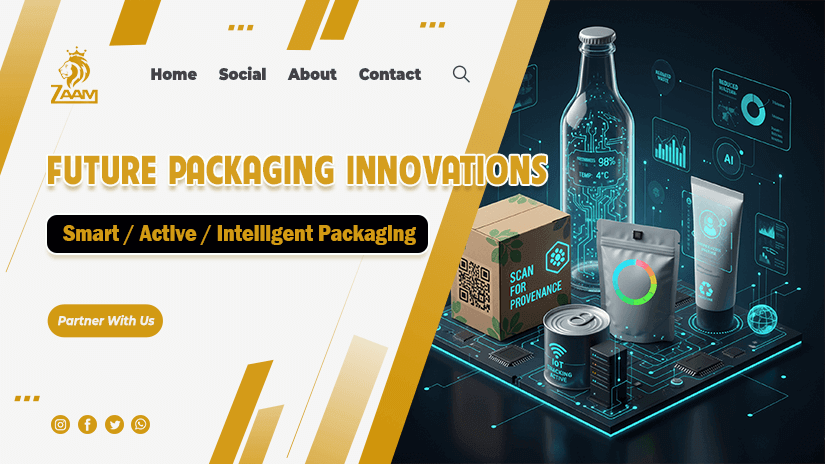Future Packaging Innovations: Smart / Active / Intelligent Packaging Leave a comment
The packaging industry is evolving rapidly. It’s no longer just about protecting products — it’s about connecting, informing, and innovating. Today, smart packaging innovations are reshaping how brands interact with consumers and manage supply chains.
From food and beverages to cosmetics and healthcare, companies are adopting intelligent packaging solutions that make packaging smarter, safer, and more sustainable than ever.
What is Smart Packaging?
Smart packaging is packaging that uses technology to communicate, monitor, or respond to the environment around it. It can include sensors, QR codes, or embedded chips that track temperature, freshness, or product authenticity.
There are three main types of smart packaging:
- Active packaging: extends product shelf life by controlling moisture, oxygen, or bacteria.
- Intelligent packaging: provides real-time data, like freshness indicators or supply chain tracking.
- Connected packaging: links customers to digital experiences through QR codes or NFC tags.
These innovative packaging technologies not only improve product safety but also enhance consumer trust.
Click here to explore how Zaam International’s plastic packaging brings smart technology to life in different industries.
Why Smart Packaging Matters for the Future
Smart packaging innovations isn’t just a trend — it’s the future of the packaging industry. By integrating technology, it supports sustainability, transparency, and efficiency.
Here’s how it’s making an impact:
- Sustainability: Sensors and freshness indicators help reduce food waste.
- Transparency: Digital codes allow consumers to trace sourcing and authenticity.
- Operational efficiency: Data from digital packaging innovations improves logistics and quality control.
- Safety: Active layers detect spoilage or contamination early, preventing product loss.
As technology continues to advance, smart packaging trends are driving industries toward safer, more responsible, and more interactive packaging models.
Click here to see how Zaam International’s glass packaging solutions are transforming smart packaging in real-world applications.
Key Trends Shaping the Future of Packaging
Let’s look at some major smart packaging innovations that are leading the way:
- IoT Integration: Packaging connected to the Internet of Things (IoT) enables live tracking and data sharing.
- Eco-Friendly Materials: Brands are combining biodegradable materials with smart features for sustainable smart packaging.
- AI Analytics: Smart data helps predict demand and improve product storage.
- Personalized Digital Experiences: Interactive packaging links to loyalty programs, games, or brand stories.
- Blockchain Tracking: Enhances product authenticity and transparency across supply chains.
These connected smart packaging innovations — from smart sensors to innovative tin packaging — are setting a new standard where packaging becomes a bridge between brands and customers.
Zaam International: Your Partner in Smart Packaging Innovation
At Zaam International, we believe that smart packaging innovations is more than just a container — it’s a communication tool.
We specialize in designing and producing intelligent packaging solutions that combine technology, sustainability, and functionality. Whether you need packaging for food, cosmetics, or healthcare, our team helps you build products that meet both global standards and modern consumer expectations.
With a focus on innovative packaging technology, Zaam International is committed to helping brands implement sustainable smart packaging strategies that enhance product safety, traceability, and engagement.
Click here to contact Zaam International and discover the right smart packaging innovations for your brand.
Conclusion
Smart packaging innovations are redefining how products connect with people. They help brands stay ahead of trends, protect their products better, and build stronger consumer relationships.
At Zaam International, we’re ready to support your journey toward a smarter and more sustainable packaging future.
FAQs
1. What is the difference between smart and active packaging?
Smart packaging monitors and communicates product information, while active packaging directly interacts with the product to maintain freshness or quality.
2. Does smart packaging cost more?
It may require a higher initial investment, but it reduces waste, improves logistics, and increases customer trust — making it cost-effective in the long run.
3. How does smart packaging support sustainability?
It minimizes waste, uses eco-friendly materials, and enables recycling or reuse through digital tracking.
4. Can small businesses use smart packaging?
Absolutely. With digital tools like QR codes and interactive labels, even small brands can create connected, intelligent packaging at a reasonable cost.

